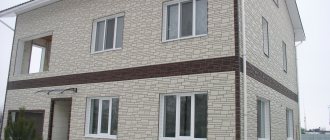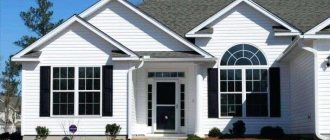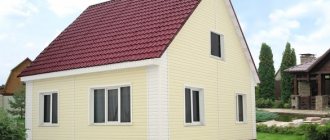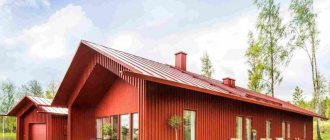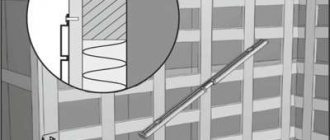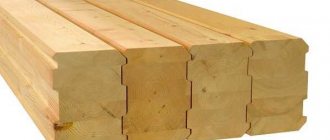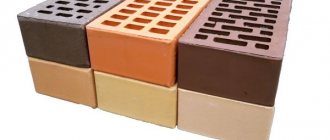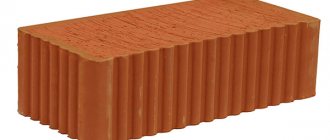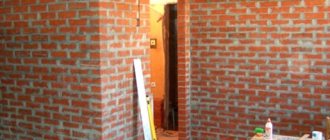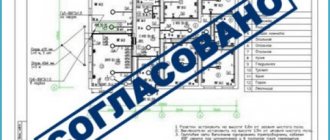Vinyl siding is decorative panels that are used for exterior and interior decoration of residential buildings, administrative buildings, industrial facilities, and household premises. It has earned its popularity due to its optimal physical and mechanical properties, affordability and ease of installation. The combination of decorativeness, practicality and versatility allows the products to be widely used for cladding respectable facades or parts thereof, and creating stylish interiors.
What is vinyl siding
The finishing panel is a plate up to 1.2 mm thick with locking fastening along the longitudinal edges. The top edge is perforated for ease of installation.
Profiles are installed sequentially. The first element is fixed to the frame or wall. Then a panel with a groove along the bottom edge is placed on the tongue of the plastic board. The upper part is nailed or screwed through the holes with self-tapping screws. With the subsequent part, exactly the same operation is performed.
The shape of the product is borrowed from the original source of siding - the North American version of board cladding. Each upper trim element is mounted above the lower one with a slight overhang. Thanks to this, snow, rain or wind do not penetrate under the cladding, and the walls remain dry in any weather.
Vinyl siding began to be produced in the 50s of the last century. The impetus was the revolution in the chemical industry and the emergence of affordable plastics. Polyvinyl chloride, which makes up 80% of the decorative panel, is produced by the polymerization of chlorine and crude oil.
Installation of the finishing panel under the roof eaves.
The finishing role is played by an ordinary siding panel. A finishing or J-profile, sets of finishing and J-profiles, or internal corner and finishing profiles are attached under the cornice. In several places along the long side of the siding, measure the distance from the lock of the penultimate row panel to the bottom of the finishing profile gutter. The vertical temperature gap of 1 - 3 mm is subtracted from the resulting value. The result is transferred to the siding panel, from which the upper locking part is cut off.
Hooks are made in the upper part of the remaining piece. They should be located at a distance of about 20 cm from each other. The hooks are bent to the front side of the panel. The panel with hooks is inserted into the lock of the penultimate panel, and its upper part is inserted into the finishing profile. The siding is lifted up so that the hooks and locks snap into place.
Production
PVC siding is produced by coextrusion - combining layers at the molecular level. At the same time, the resulting material has new and improved properties. Previously, the monoextrusion method was used to produce profiles, but it is now considered obsolete.
The molten mass of PVC, chalk, pigments, stabilizers and modifiers is passed through a slotted die. With the help of rollers, the front surface of the profile is given the desired texture, and a calibrating installation sets the final shape of the products.
Special machines punch holes in the edges and automatically cut the panels. Dimensions of finished products:
- length - 3050-3850 mm;
- width - 203-254 mm;
- thickness - 0.9-1.2 mm.
The base of the polymer product - a mixture of PVC and calcium carbonate - is located in the bottom layer of the panel. The price of vinyl siding depends on its quality.
Important. The base retains the shape of the product, gives it strength and heat-protective properties. It is allowed to use the addition of recyclable materials - no more than 5%. Otherwise, this significantly degrades the performance of the material.
The outer layer protects the profile from ultraviolet radiation, temperature fluctuations, and aggressive environments. Its thickness is at least 2 mm. Special additives prevent discoloration, separation, peeling or swelling.
For what reasons are people increasingly choosing siding for exterior decoration?
Since the beginning of the 90s, polymer profiles have become very popular, displacing traditional finishing materials and methods - wood cladding, plaster, tile, brick or clinker cladding.
Important. Exterior vinyl siding has successfully replaced labor-intensive processes and expensive natural materials. Costs were reduced by 4-6 times, and the speed of work increased significantly due to the high technology of installation.
Laying profiles can be done even by a beginner who knows how to hold tools in his hands. Lightweight plastic boards are easy to cut, install and secure yourself. Professional teams sheathe large volumes and finish buildings with complex geometries in a short time.
There are no requirements for base surfaces. On the contrary, slight curvature or small defects can be corrected when installing the siding on the sheathing. The main thing is that the wall is not too shabby, otherwise it will not be possible to firmly secure the frame.
Finishing work is often combined with insulation. A layer of thermal insulation made of mineral wool slabs or expanded polystyrene of the required thickness is laid under the sheathing. Due to this, while saving time on work, the energy efficiency of the building increases.
The polymer material, having low thermal conductivity, creates a protective barrier and retains heat in the room. Condensation does not linger on the surface of ventilated facades made of vinyl siding, unlike metal siding. The wall remains dry even with significant fluctuations in temperature and humidity.
A variety of colors, shades and textures of panels from traditional to unusual allow you to decorate an object in any style you like. Exterior vinyl siding will protect and decorate a modern mansion, classic country estate or country house.
The main advantages of vinyl siding
The most valuable properties of plastic elements:
- High durability. Manufacturers of high-quality material claim a full service life of 50 years.
- Reliable protection from precipitation. Thanks to the profile shape, water does not get under the casing.
- Low flammability (class G1 or G2), at high temperatures the material melts but does not burn.
- Resistance to biological degradation. Polymers do not rot and are unattractive to insects and rodents.
- Resistant to temperature fluctuations within +50°С…-50°С.
- Non-toxic, environmentally friendly. PVC does not emit harmful substances or radiation into the environment.
- Durability, relative resistance to external mechanical influences, scratches on the surface are almost invisible.
- Lightweight elements, no need to strengthen foundations and walls, reduced delivery costs.
- Easy to care for. Simply hose down the surface with plain water or a mild detergent.
- Decorative.
- Maintainability.
When finishing with siding, the panels are often placed horizontally, but they can be installed vertically or at an angle. This will give the external appearance of the building originality and uniqueness.
Siding in wall cladding
Upon completion of the foundation cladding, the basement flashing is installed. If the entire facade is covered with siding, then among its accessories there will be an option that is suitable for this purpose.
This is a drain strip, which is also installed along the lower perimeter of the windows.
- It is mounted on the base only if the foundation has a sinking or protruding structure, or different materials are used to finish the base and walls. If their surfaces are in the same plane, and the entire height is covered with, say, basement siding, the drain can be organized not from above the base, but from below.
Design of a façade completely covered with vinyl plinth siding
- Even if the walls are in the same plane as the base, but you decide to cover them not with base siding, but with façade siding, you will need to mount the starting strip again. But first, the frame. Its structure will depend on whether the walls are intended to be insulated. If so, then you will need to install two sheathings: one wooden, in the cells of which the insulation will be laid, and the second from a profile, already under the siding.
Although, nothing prevents you from making both lathing from wood - it’s up to you to decide. We will not go into the details of insulation now. On our website there is a detailed article on the construction of a ventilated facade.
Disadvantages of vinyl siding
Despite the huge advantages, using this material also has its disadvantages, which we will briefly discuss in this paragraph:
- Vinyl siding panels cannot be repaired and therefore, if damaged, the entire piece will have to be replaced.
- When temperature changes occur, there is a possibility of panels shrinking and stretching; this must be taken into account during installation.
- We will talk about installation separately in another article, but if you do not have certain skills and your hands are not exactly “golden,” it is better to trust the work of professionals.
Components and additional elements
To cover the facade with vinyl siding, the following additional elements will be required:
- starting, finishing and near-window profiles;
- outer and inner corners;
- T-profile;
- cornice board;
- J-profile;
- soffit;
- molding;
- H-profile;
- door frame;
- J-chamfer.
The components make the work easier and help to beautifully decorate the façade in the shortest possible time.
Features of the material
Vinyl siding for a home has a number of features that need to be taken into account during transportation, installation and operation.
The coefficient of linear thermal expansion of vinyl is 5.1-5.8 *10 ˉ⁵cm/m. When heated from 5°C to 40°C, the panels lengthen by 10-12 mm. To prevent the siding from warping or bursting, the elements are installed with a gap during installation. It compensates for deformations and maintains the integrity of the structure.
Vinyl siding is flexible and can withstand significant tensile forces - up to 600 kg/cm². But its impact resistance is low. The average impact resistance of materials from Russian manufacturers is 3.4-8.6 J according to the ASTM standard. At negative temperatures this figure is even lower.
Important. To prevent cracks and dents from appearing, you need to avoid harsh impacts and use a high-quality cutting tool. In the cold, polyvinyl chloride becomes brittle. Therefore, installation is carried out at positive temperatures.
Varieties
Vinyl siding for exterior decoration is used for cladding vertical and horizontal surfaces. The profile is released according to its purpose:
- wall;
- basement;
- soffit.
Wall elements imitate the texture of painted wood. In production they are given the following shape:
- “herringbone” - plates with one or two bends, reminiscent of overlapping boards;
- “ship beams” - imitate tightly joined boards of a ship’s deck;
- “house block” - the relief covering is very similar to the surface of a wall made of rounded logs or profiled timber.
The profiles create a three-dimensional effect of wood paneling. The color variety is very large - from delicate pastel shades to rich bright tones.
To cover the base, denser and thicker siding is used. It is shorter and stronger than wall, and can withstand heavy loads. The outer surface imitates brickwork, wild untreated stone, slate, tuff, granite, and shell rock. The combination of wood-look wall elements is effective. Sometimes the building is completely covered with basement siding.
Soffits, as a rule, are hemmed with horizontal or inclined elements - ceilings, roof overhangs, cornices, ridges. The parts can be perforated across the entire width, in the central part, or smooth.
The gable overhangs are hemmed with continuous soffits. For finishing structures where condensation accumulates, profiles with perforations are used.
A type of vinyl is acrylic siding. It is more resistant to solar radiation and high temperatures, and retains its bright color for a long time.
The best manufacturers
Purchasing high-quality vinyl siding will make the work easier, eliminate a lot of waste, and allow you to enjoy a beautiful façade for many years.
Mitten
The Canadian company Mitten specializes in vinyl products and is considered the best siding manufacturer. The high price of the material justifies itself. Strict quality control in production ensures color fastness and prevents panels from fading during operation.
Boryszew
Modernity, neatness and clear lines are the three main components of the Polish company Boryszew. The use of special components makes the siding visually attractive, reliable, durable and weather resistant.
Royal
Strict production control and high quality vinyl panels allow the Canadian company Royal to occupy a leading position in the construction market. The uniform coloring and rich colors of their vinyl products are maintained throughout the entire period of operation.
KANADA Plus
The use of advanced technologies from KANADA Plus, combined with global experience, contributes to the creation of high-quality materials that can withstand increased competition.
Dock
Multiple quality control at each stage of production allows the German company Docke to occupy a leading position in sales of vinyl siding. Modern scientific developments in our own laboratories contribute to the creation of high-tech materials that are resistant to environmental influences.
Installation rules
To ensure that vinyl siding for a home does not deteriorate for a long time and does not lose its properties, certain rules are followed when installing it:
Read a detailed article about installing siding yourself by clicking on the link.
- Before starting work, the surface is cleaned, cracks are sealed, and covered with antiseptics and fire retardants.
- Install a sheathing made of aluminum profiles or wooden blocks, firmly securing it to the wall. Check the geometry with a liquid or laser level.
- For insulation, steam, heat-insulating and waterproofing materials are laid.
- Installation begins with the starting element, placing it at the bottom.
- Plastic boards are laid sequentially, observing temperature and ventilation gaps - 5-7 mm and 30-50 mm. Special components are used to design joints and joints.
- Finishing is completed with a finishing strip.
Facade preparation.
Before installing the siding, all façade finishing work is completed. All the seams in the chopped walls are caulked. All unnecessary nails are pulled out from the walls, drainpipes and other hanging “extra” elements that will interfere with installation are removed. Remove trim from window and door openings. Rotten and broken boards are replaced with new ones. All loose structures are secured. If necessary, arrange thermal insulation.
Find out from our article: Which thermal insulation to choose for the facade of a house
How to increase the service life of siding
There are simple rules, following which you can increase the life of vinyl siding.
- Ten years later, some parts of the siding may become discolored, this happens, you just need to remove and replace them.
- Control insects as they can cause significant damage to vinyl siding.
- To keep your house warm, install high-quality thermal insulation before installing siding.
- About once a year, the siding needs to be cleaned; for this, use a special washing machine, or simply use a hose with water.
- Siding cannot be painted, it has a certain tint, the color will not flake off and scratches are not visible on the material, its properties do not suggest options for painting during operation.
These little expert tips will help you avoid investing extra money in exterior decoration for many years, which will allow you to save a significant part of your budget.
Photos of beautiful examples of finishing houses with siding
The editors of the site stroim-dom.net have selected for you several attractive options for the design and style of your home. Light pink tones at home will never irritate you and can create a light and calm environment.
Photo of finishing with slatted vinyl siding
The option of finishing with slatted vinyl siding will make you stand out among all the houses; it will look especially creative together with imitation masonry siding; in this case, it is used to finish the base. From a distance, it is practically indistinguishable from shipboard, the finishing of which would cost simply “cosmic” money.
Photo of finishing in English style
For those who want the house to look expensive and rich, you can use white siding; this will give the house elegance and allow it to fit into any modern design, similar to the English style.
Photo of imitation rounded timber
If the house is located in the middle of a forest, you can choose an imitation of rounded logs as decoration; your house will look like a fairy-tale mansion.
Photo of partial finishing of the house with siding
Partial use of siding to highlight certain details of the home will help give the house an original appearance.
In order for your home to be original, you should carefully consider the choice of colors; contrasting shades will look great in pairs, you will be able to stand out among many gray houses and give a unique look to your home.
